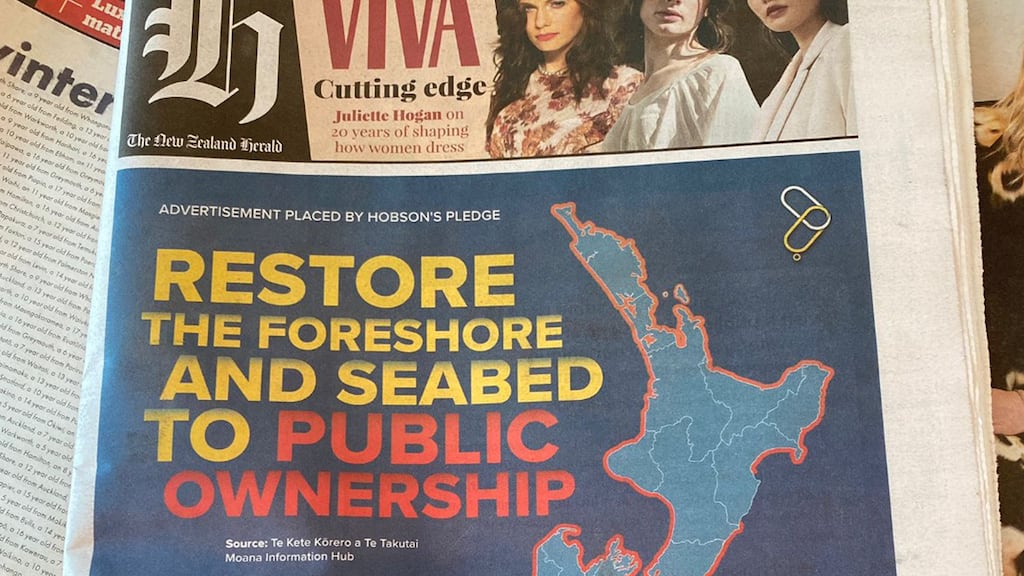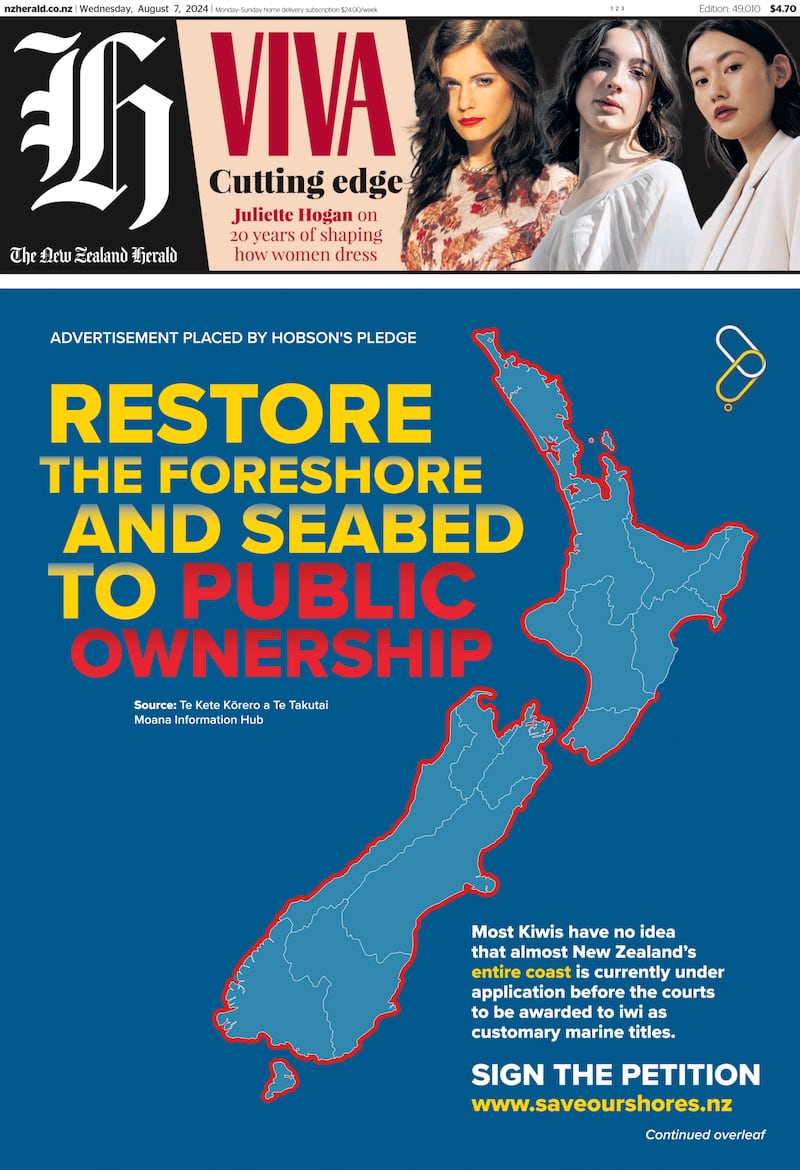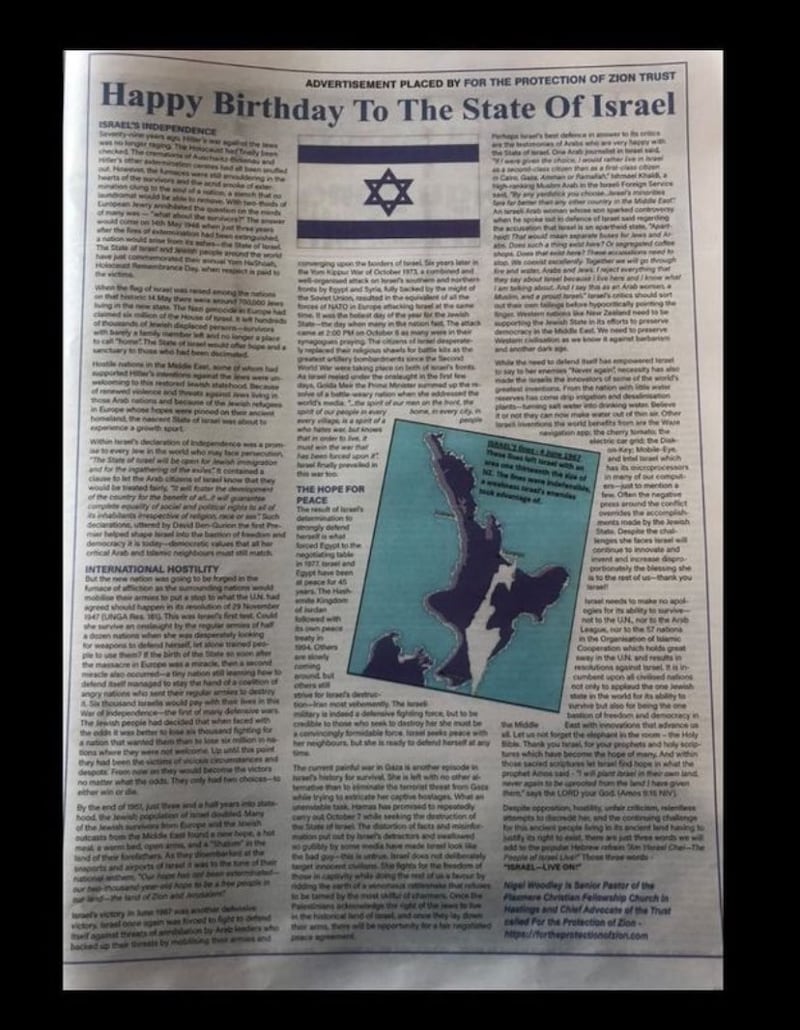Thursday 8 August 2024 • ByShilo Kino, former NZME reporter

Shilo Kino is an award-winning author and was a freelance columnist with Newsroom, the Guardian and the Spinoff. She has reported for TVNZ’s Marae as well as the New Zealand Herald.
OPINION
On Wednesday, August 7, one of the country’s largest media publications decided to feature a full-page advertisement from a right-wing extremist group on its front page.
“Restore the foreshore and seabed to public ownership,” reads the headline from the Hobson’s Pledge group, known for spreading misinformation that incites harm and racism against Māori.
At first glance, the advertisement appears to be a news article. This is intentional, designed to mislead readers into believing the content is factual.

The headline aims to induce fear or distress without justification. Publishing this on the front page is not just harmful — it’s propaganda disguised as news.
The seabed and foreshore issue demands truthful reporting with historical context and analysis. But this isn’t even about Hobson’s Pledge, a group well known for inciting racism under the guise of “we are all New Zealanders.”
The bigger question is: What is the moral obligation and responsibility that lies within media institutions in allowing advertisements like this to be published?
What constitutes an ad, and what constitutes false information that is harmful and callous?
What can we do about it?
In May this year, the Herald published a full-page advertisement from a Zionist group defending Israel, the very state responsible for one of the largest genocides in modern history.
At a time when 35,000 Palestinians were murdered at the hands of the state, I was shocked and could not comprehend how the Herald leadership team—editorial or advertising — could allow an ad like this to be printed.

An ad that spoke of “the hope for peace” and “the need to defend Israel,” a romanticised distortion of events that bears no resemblance to the horrific reality unfolding before us.
I emailed both the commercial editor and news editor, saying that the advertisement from the Zionist group violated the Advertising Standards Authority codes of truthful presentation, which mandates that advertisements must be truthful, balanced, and not misleading.
The advertising team’s reply was:
“The content you refer to is a paid advertisement from an independent advertiser and is clearly labeled as such.”
I believe that a clear line needs to be drawn between advertising and media, and what is morally acceptable and what isn’t.
What is the moral obligation that lies within media institutions?
For example, would an advertisement promoting Nazi ideology be allowed to be published? No, it wouldn’t because it promotes a dangerous and harmful ideology.
I lodged a complaint with the Advertising Standards Authority and my complaint was not upheld.
The responsibility of the media
The NZ Herald, which reaches 598,000 readers, should not publish content simply because it is paid for.
There is an expectation and duty to readers that ethics and principles should guide decisions, and both the commercial and editorial teams should exercise better judgment.
Publishing such an ad in both examples is extremely harmful and dangerous. Allowing misinformation or provocative material without proper analysis can have serious consequences for our communities here in Aotearoa.
In a democracy, the media have a duty to inform the public accurately. Allowing propaganda to masquerade as advertising undermines this principle and threatens democratic discourse.
The NZ Herald has allowed its platform to disseminate misinformation, which contradicts responsible journalism principles.
The same scrutiny and ethical considerations should apply to all advertisements. When a newspaper permits biased or prejudiced content, it fails to present a truthful and comprehensive view of events.
This failure can mislead the public, distort perceptions, and ultimately undermine the democratic process, which relies on an informed electorate.
It is my belief the Hobson’s Pledge advertisement breaches the Advertising Standards Code in causing harm, or serious or widespread offence and fear or distress without justification.
The bigger picture
It is no secret that journalism in this country is in trouble.
We’ve seen the end of the longest and most important current affairs show Sunday, the end of Newshub, and widespread job losses across the industry.
I am a former journalist and I believe strongly in the role of the media and the fourth estate. The media has a responsibility to hold those in power into account.
Everything comes at a cost but I refuse to accept the cost those are willing to pay for the sake of revenue.
Allowing the Hobson’s Pledge group to advertise on the front page is harmful and destructive, using the guise of free speech to bypass accountability for the damage these kinds of narratives cause.
The narrative further perpetuates what feels like a massive assault on our language, on our whenua, on our sacred text Te Tiriti o Waitangi, on our tamariki, and on our ways of being.
We are fighting against a system that is distracting us from what is most important: asserting tino rangatiratanga in our lives, raising our tamariki, knowing our whakapapa, our reo, and connecting back to who we are. This is the most important work we can do.
But it seems every other day, we are constantly fighting to justify our very existence.
The Hobson’s pledge advertisement is just another example.




